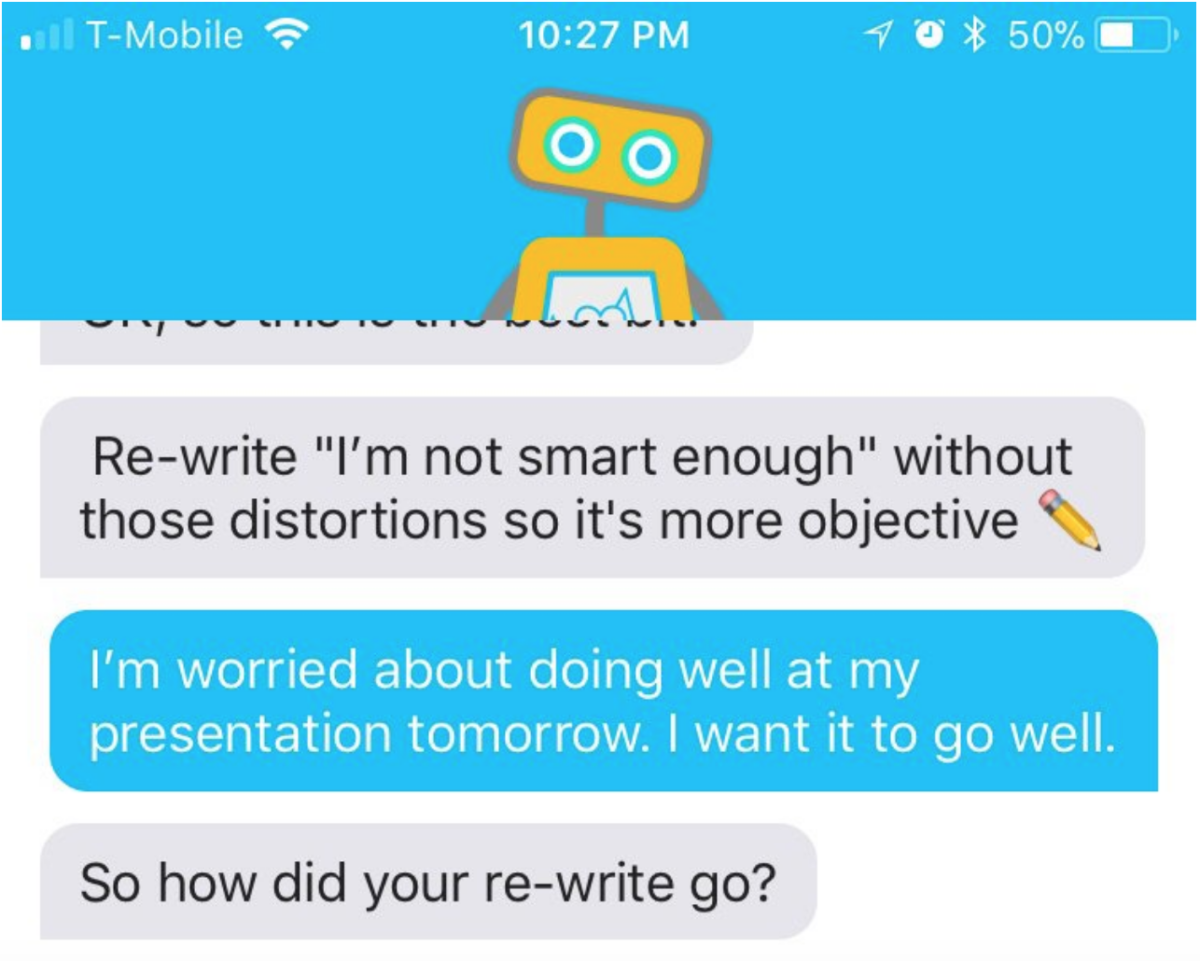January 30, 2018.
Approximately 1 in 5 Americans who have a mental illnesses have gone at least one year without treatment. In 2017, Alison Darcy, a clinical psychologist at Stanford University created Woebot, an AI powered chatbot app that uses cognitive-behavioural therapy to help people cope feelings of depression and anxiety.
Erin Brodwin writes about her experience using the app for two weeks. To her surprise, Woebot was helpful especially in the middle of the night when she felt like she did not want to bother her therapist. Woebot was not made to replace therapists, but instead it was created to give people more options and access to different kinds of treatment.
I find this app extremely interesting because if you read the article and look at the screenshot photos of Erin using the app, you can see that the app feels like you’re talking to a friend or playing a game of sorts. The chatbot uses emojis and GIFS, making the cognitive behavioural therapy experience completely different and in the palm of your hand at all times. Woebot remembers your conversations and saves your goals, making the interactions with the chatbot feel more personal. For people who have anxiety and depression, this app could be a lifesaver in many moments where you feel alone and uncomfortable. Woebot intrigues me because I can imagine people using the app on the bus, before a big presentation, and at home.
There are now many startups and companies who are experimenting and constantly improving the digital therapy industry. Other similar AI mental illness applications include: Pacifica, Moodkit, Moodnotes, and Wysa. For now, the chatbots are quite limited to responding to the user’s short descriptions but the next challenge for developers will be to involve natural language processors for text and speech.
What do you think? Would you use the app?
https://www.businessinsider.com/therapy-chatbot-depression-app-what-its-like-woebot-2018-1?international=true&r=US&IR=T#the-first-message-appeared-around-6-pm-while-i-was-on-the-bus-i-cupped-a-hand-around-my-phone-and-stole-a-furtive-glance-at-the-gray-bubble-on-the-screen-1
https://www.techemergence.com/chatbots-mental-health-therapy-comparing-5-concurrent-apps-use-cases/


Hello Connie,
I think the topic you chose is very interesting and relevant as this is one of the current challenges in our society, and people tend to forget about this dimension of health, although it is so important.
I would like to know more about your own opinion about this topic regarding the future trends of this kind of technology. I think we can even make a link with what was said yesterday during the guest lecture about AI and human interaction, and to what extent AI’s abilities may overcome the other’s. Do you think this could be considered as a substitute to a human therapist in some cases?
In my opinion, this could lead on the middle term to undesired behaviors, by making the people more introvert regarding their problems, which could be detrimental for their mental health at the end of the day. Of course, I also understand how relevant this technology can be, especially in the early stages of the treatment consisting in communicating to someone about how you feel. I have also really appreciated the part where you emphasized that the answers you receive from the robot are increasingly personalized. However, I strongly believe that for “mental illnesses” this should constantly be used in collaboration with a (human) therapist, as otherwise some deviances might occur. Even for cases such as a stressful situation, I feel like the app is offering more of a short-term help by focusing on the symptoms rather than truly answering to the problem.
What do you think about it? Do you think that one day this technology will be advanced enough to surpass the human ability as well as the human + AI ? Or is this one of the (few?) cases where the human involvement is still crucial and cannot be replaced?
Thank you for writing about this topic and for sharing your opinion on this!
Kind regards,
Sabrina
Hi, Connie. Thank you for sharing this blog, which is a very interesting read. I agree with what you said in this blog “Woebot was not made to replace therapists, but instead it was created to give people more options and access to different kinds of treatment”.
In my opinion, the use of AI technology in mental health has been improved, but not yet mature while many obstacles remain to be solved. For example, individuals with different personalities or from different cultural backgrounds have different habits of thinking and different ways of expression. Since the AI-powered chatbot app, like Woebot, always follow a pre-defined script or pre-set text. How to solve the situation when the AI-powered chatbot app is not able to correctly understand users and their intentions? And how to solve the situation when users are not satisfied with the answer provided by the AI-powered chatbot app? These are tough questions that still face by app developers. Do you think these questions can be solved in the future? At least currently, I think an AI-powered chatbot app can only be used to assist human therapists to some extent, but cannot replace human therapists.